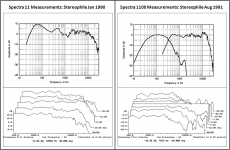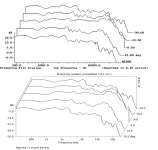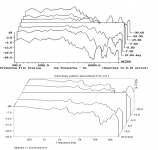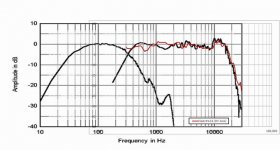Acoustat Spectra 11/1100 Reviews (includes measurements)
In case anybody missed it, thought I would post links to these recent archived reviews from Stereophile.
Acoustat Spectra 11 loudspeaker Measurements | Stereophile.com
Acoustat Spectra 1100 loudspeaker Measurements | Stereophile.com
Two things that caught my eye in the measurements were the dramatically different on-axis response and horizontal polar response. It was my understanding that the Spectra 11 and Spectra 1100 shared essentially identical ESL parts, only the woofer/crossover and cosmetics were changed.
After a careful read through the text of the measurement section I determined the reason for the difference in the on-axis response. The Spectra 1100 measurement had the mic placed vertically at the center of the ESL panel. The Spectra 11 measurements had the mic placed 36” from the floor(JA’s “normal” listening height). This puts the mic well below the vertical center of the ESL panel and would account for the rolled off highs.
The disparity in horizontal response curves was puzzling as they should be near identical since both measurement sets were taken with mic placed at the center of the panel. Then I noticed that in each review, the +15/-15 curves matched each other as did the +30/-30 curves. JA obviously had measured the horizontal response in only one direction(not both) and just mirrored the data. This works fine for most speakers, but the Spectra 11/1100 has an asymmetric panel layout resulting in better dispersion to one side than other. My guess is that the Spectra 11 review shows measurements taken to the listener side, and the Spectra 1100 review shows measurements taken to the sidewall side.
It is not a subtle difference, and a good reminder to make sure you have your Spectra Left & Right speakers placed on the correct side of your setup for smoothest/broadest response.
In case anybody missed it, thought I would post links to these recent archived reviews from Stereophile.
Acoustat Spectra 11 loudspeaker Measurements | Stereophile.com
Acoustat Spectra 1100 loudspeaker Measurements | Stereophile.com
Two things that caught my eye in the measurements were the dramatically different on-axis response and horizontal polar response. It was my understanding that the Spectra 11 and Spectra 1100 shared essentially identical ESL parts, only the woofer/crossover and cosmetics were changed.
After a careful read through the text of the measurement section I determined the reason for the difference in the on-axis response. The Spectra 1100 measurement had the mic placed vertically at the center of the ESL panel. The Spectra 11 measurements had the mic placed 36” from the floor(JA’s “normal” listening height). This puts the mic well below the vertical center of the ESL panel and would account for the rolled off highs.
The disparity in horizontal response curves was puzzling as they should be near identical since both measurement sets were taken with mic placed at the center of the panel. Then I noticed that in each review, the +15/-15 curves matched each other as did the +30/-30 curves. JA obviously had measured the horizontal response in only one direction(not both) and just mirrored the data. This works fine for most speakers, but the Spectra 11/1100 has an asymmetric panel layout resulting in better dispersion to one side than other. My guess is that the Spectra 11 review shows measurements taken to the listener side, and the Spectra 1100 review shows measurements taken to the sidewall side.
It is not a subtle difference, and a good reminder to make sure you have your Spectra Left & Right speakers placed on the correct side of your setup for smoothest/broadest response.
Attachments
Last edited:
bolserst...........
Thanks for your time an the info.....this can make the sound much better...theres people out there now with them setup..............out of sink..........ESL are just so good even setup bad...thay sound better than most other speakers....hehe
Only one thing could be better....with my Acoustats panels when ran fullrange........sound is to diy for but..
about....86-7 db at one watt..
If i could get the SPL of my re-worket ML panels....thay got to be in the 92-94db at one watt.......
But i still have to put the ML Ascent stepup tran in place of the Acoustat high frc tran... in my 121 Acoustat interfaces.....an feed the prymary centap as ML dose with input see if that as i think it well give more-better output..................next step....
Long live Acoustats.....................
Thanks for your time an the info.....this can make the sound much better...theres people out there now with them setup..............out of sink..........ESL are just so good even setup bad...thay sound better than most other speakers....hehe
Only one thing could be better....with my Acoustats panels when ran fullrange........sound is to diy for but..
about....86-7 db at one watt..
If i could get the SPL of my re-worket ML panels....thay got to be in the 92-94db at one watt.......
But i still have to put the ML Ascent stepup tran in place of the Acoustat high frc tran... in my 121 Acoustat interfaces.....an feed the prymary centap as ML dose with input see if that as i think it well give more-better output..................next step....
Long live Acoustats.....................
Last edited:
In my Acoustat setup ....i can set my bias...i had push it up to high a day ago it was raining.. to day got less output out no rain.....had to drop it back to get more output an better sound....gofig
I don't have the tech expertise or instruments for measurement, but my ears tell me the only way my M3s sound right is when they're precisely distanced and angled in all dimensions. The hardest was finding the exact tilt to avoid a null zone at the height of my ears when I sit to listen, and matching that tilt on both speakers.
That having been said, it's not hard for me to imagine mic placement would have a tremendous effect on measured response.
That having been said, it's not hard for me to imagine mic placement would have a tremendous effect on measured response.
I agree entirely that is IMPERATIVE to have the left & right Spectra speakers oriented properly. Having them backwards sounds just plain weird and may lead to thoughts of suicide. 😱
There IS a potential difference in top-end response between the 11 and 1100. The Spectra 11 has a fixed 1-ohm resistor in series with the audio transformer, which was done to limit the minimum impedance at high frequencies. The thinking was that the budget-priced 11 would typically be used with budget-priced amplifiers, which might be unstable under those conditions. The 1100 has a hi-frequency balance switch, which offers 1, 0.4, or zero ohms in series with the audio transformer. In other words, the LO position of the 1100's switch is equivalent to the standard 11 response. Since most people use the HIGH (zero ohms) position, the 1100 typically has a more extended top end. This is reflected in the graphs presented.
HINT to owners of the Spectra 11: you can lower the value of that resistor even down to zero, as long as your amplifier is up to the task. This will add a bit of top-end sparkle.
The Spectra 11 polar response graph has me a bit puzzled, as it doesn't seem to contain the usual normalized straight line for the zero-degree response. But certainly, due to Spectra's asymmetric response, the left and right polar response should look different.
Large planar speakers can be difficult to measure, and unless two different speakers are measured using identical techniques in identical environments, comparing the results are pretty much useless.
There IS a potential difference in top-end response between the 11 and 1100. The Spectra 11 has a fixed 1-ohm resistor in series with the audio transformer, which was done to limit the minimum impedance at high frequencies. The thinking was that the budget-priced 11 would typically be used with budget-priced amplifiers, which might be unstable under those conditions. The 1100 has a hi-frequency balance switch, which offers 1, 0.4, or zero ohms in series with the audio transformer. In other words, the LO position of the 1100's switch is equivalent to the standard 11 response. Since most people use the HIGH (zero ohms) position, the 1100 typically has a more extended top end. This is reflected in the graphs presented.
HINT to owners of the Spectra 11: you can lower the value of that resistor even down to zero, as long as your amplifier is up to the task. This will add a bit of top-end sparkle.
The Spectra 11 polar response graph has me a bit puzzled, as it doesn't seem to contain the usual normalized straight line for the zero-degree response. But certainly, due to Spectra's asymmetric response, the left and right polar response should look different.
Large planar speakers can be difficult to measure, and unless two different speakers are measured using identical techniques in identical environments, comparing the results are pretty much useless.
I agree, it is a bit apples-oranges trying to compare the normalized Spectra 1100 polar response with the un-normalized Spectra 11. To provide a better comparison and get a better handle on the amount of top octave “beaming” on either side of the Spectra panel, I used a curve tracer to pull the Spectra 11 responses into ARTA to re-plot them normalized.The Spectra 11 polar response graph has me a bit puzzled, as it doesn't seem to contain the usual normalized straight line for the zero-degree response. But certainly, due to Spectra's asymmetric response, the left and right polar response should look different.
Attachment #1: Shows comparison of the published source data vs the curve trace data. The viewing angle for the isometric is slightly different with ARTA, but it is easy to see we are dealing with the same response curves. Response is slightly smoother as ARTA added 1/12oct smoothing, but all the trends and wiggles overlay nicely.
Attachment #2: Shows comparison between normalized Spectra 1100 curves(top plot) and the normalized Spectra 11 curves I created with ARTA from the published un-normalized data shown in Attachment #1. It is now very obvious that(relative to on-axis) at 15 degrees off axis the Spectra 11 data is only slightly shelved down at 10Khz with a shallow roll-off starting above that. At 30 degrees, response still holds up nicely to 10khz, but the roll off is now rather abrupt above that. By comparison, the Spectra 1100 data shows 10khz down by 18dB or more at 15 degrees off axis. By 30 degrees, the steep roll off is starting by 3khz and lobing is starting to occur just above 10kHz.
To investigate how different the on-axis response of the Spectra 11 was compared to the Spectra 1100(with switch in the middle position) I used the on-axis data from the Spectra11 polar plot I had traced into ARTA.There IS a potential difference in top-end response between the 11 and 1100. The Spectra 11 has a fixed 1-ohm resistor in series with the audio transformer, which was done to limit the minimum impedance at high frequencies. The thinking was that the budget-priced 11 would typically be used with budget-priced amplifiers, which might be unstable under those conditions. The 1100 has a hi-frequency balance switch, which offers 1, 0.4, or zero ohms in series with the audio transformer.
Attachment #3: Scaling the dB and frequency axis to match, the Spectra 11 on-axis top-octave response is nearly identical to the that published for the Spectra 1100.
Attachment #4: Scaling the dB and frequency axis to match, the Spectra 11 on-axis response is compared to the response taken lower down on the panel(ie 36” from ground). It is easy to see why it was recommended to listen on the panel axis.
The pair of Spectra11s I worked on some 15 years ago(bias supply was acting up) had 0.47 ohm resistors in series with the primary which appeared to be stock...no evidence of re-soldering. Any idea if there was ever a change from the 1 ohm you mentioned to a 0.47 ohm? After trying values ranging from 1 ohm to 0 ohm, the owner decided he liked 0.22 ohm best overall.
Attachments
In my Acoustat setup ....i can set my bias...i had push it up to high a day ago it was raining.. to day got less output out no rain.....had to drop it back to get more output an better sound....gofig
When it was raining, you could push the bias setting higher because the humidity was causing increased leakage current on the panel, reducing the amount of charge on the diaphragm. When the humidity went away, the charge on the diaphragm increased to the point that the diaphragm collapsed to one of the stators. This is why you were getting less output. Dropping the bias voltage reduced the charge on the diaphragm enough to allow it to pull free from the stator and move in the middle of the gap restoring output and giving better sound quality.
When it was raining, you could push the bias setting higher because the humidity was causing increased leakage current on the panel, reducing the amount of charge on the diaphragm. When the humidity went away, the charge on the diaphragm increased to the point that the diaphragm collapsed to one of the stators. This is why you were getting less output. Dropping the bias voltage reduced the charge on the diaphragm enough to allow it to pull free from the stator and move in the middle of the gap restoring output and giving better sound quality.
I agree, and hence my steadfast recommendation to leave the bias at the factory-determined level. Much experimenting was done in varying levels of humidity and altitude to arrive at the best bias voltage that would work under all conditions.
The pair of Spectra11s.... had 0.47 ohm resistors in series with the primary which appeared to be stock...no evidence of re-soldering. Any idea if there was ever a change from the 1 ohm you mentioned to a 0.47 ohm? After trying values ranging from 1 ohm to 0 ohm, the owner decided he liked 0.22 ohm best overall.
Hmmm...that does ring a faint bell way in the back of my brain. It may be that our experience with the 1100 taught us something that prompted a change in the Spectra 11 resistor from 1-ohm to 0.47-ohms. It certainly does make sense, and as mentioned earlier, this value can go down to zero if the amplifier can handle it.
Last edited:
Question for those with experience of accoustats, how do the 1100s compare to other models? Is there a consensus about which accoustat model was the best ?
Question for those with experience of accoustats, how do the 1100s compare to other models? Is there a consensus about which accoustat model was the best ?
Of all I have owned / heard - Model 1, Model 2, Model 3, Spectra 22, Spectra 11, I like my 2+2 best, with Spectra 22 close behind, followed by Model 3. For me, more panels, better sound.
Of course I cannot leave anything alone, so I have a few tweaks here and there (C-Mod, raise bias 1kv, charge indicator, etc)...
Question for those with experience of accoustats, how do the 1100s compare to other models? Is there a consensus about which accoustat model was the best ?
Since you referenced the Spectra 1100, I'll start with the Spectra models. One of the goals of the Spectra series was to address the age-old compromise between small-area narrow arrays, which offer superior sound stage but lousy efficiency and bass response, and the large-area wide arrays that have superior efficiency and bass response but lesser sound stage accuracy. By using an electrically shaped dispersion pattern, all Spectra models exhibit a very similar and excellent sound stage character, with the result that each progressive model offers an increasing level of efficiency and bass response. So with the Spectra series, you get what you pay for, subject to the limitations of budget, spousal acceptance factor, and room size (not necessarily in that order).
Unfortunately, the pre-Spectra models were victims of this compromise, so it's much harder to say which model was the best. Models like the 1+1 are prized by some for their excellent imaging character, but disliked by others for their limited dynamics and wimpy bass response. Larger models like the 3 or 2+2 are favored for their high output and improved bass response, but those owners sometimes wish their speakers imaged as well as the single-panel-wide models.
In terms of popularity, the 3-panel-wide configuration probably sold the most, as it was offered, in one form or another, for all of Acoustat's history. The next popular model was probably the 2+2, which presents a pretty good 'middle ground' between imaging and bass response. That model would probably have sold even more, had it not been for the limitation of requiring a minimum 8-foot ceiling.
- Status
- Not open for further replies.
- Home
- Loudspeakers
- Planars & Exotics
- Acoustat Spectra Reviews (includes measurements)




